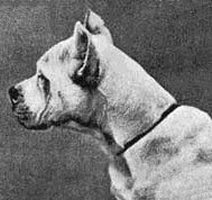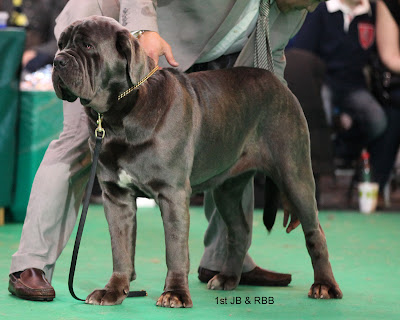The results of the 2013 Karlton Index survey have been published today. Launched last year, the aim of the Karlton Index is to highlight good practice within breed clubs, to share ideas and to "offer encouragement to all breeds in the difficult challenges faced in managing health and welfare issues."
"Its aim is also to recognise the hard work that is invested in breed health and to highlight the efforts to those who commit their time and efforts into these issues," explains Philippa Robinson, who created the Index.
Philippa is a pet owner who was "politicised" on this issue through the experience of owning a German Wirehaired Pointer, Alfie, who died aged four of idiopathic epilepsy. She now owns a gorgeous wire x weim crossbreed, in good health I believe.
Philippa first contacted me in March 2007 to tell me about Alfie and we interviewed her for Pedigree Dogs Exposed - an interview that hit the cutting room floor, not because it wasn't any good (Philippa talked fluently and passionately on the issues as she saw them) but because it was hard to stand-up, in a legally-concrete way, the claim that Alfie's breeder had been negligent. As such, Philippa appears in PDE only briefly, taking a walk with Cavalier campaigner, Carol Fowler.
After the film, the relationship continued, but we drifted apart a couple of years ago after a disastrous attempt to set up a charity designed to promote and campaign on better dog health and welfare. The reasons were several-fold but probably boil down to Philippa being frustrated with my casual acquaintance with deadlines (justified...) and me put out by how sharp she can be on occasions.
Since then, we have exchanged the occasional email - most friendly-enough; others which have doubtless made one or the other of us bridle.
Meanwhile, I continue my role as the gobby blogger scrutinising breeds and health reforms with a critical eye. And Philippa has taken a different tack: she has now forged relationships with the Kennel Club and breed clubs/breeders, feeling that this is a more positive, productive approach.
The result is a very different Karlton Index to the last one, which was largely critical (and which is no longer available on the Karlton Index website). The 2013 survey is clearly designed to encourage more than damn. And that's fair enough. There are, after all, many ways to skin a cat.
But I have a problem with the Karlton Index and it concerns what it measures and how it measures it.
For notwithstanding the huge effort that Philippa has put into this - all on an unpaid, volunteer basis - the Karlton Index doesn't actually measure progress in health (as it claims) - it mostly measures the appearance of health.
Just like dog shows.
So, for example, breed clubs get marks for disseminating health information, for conducting surveys and publishing the results, for holding health seminars and for out-reaching to pet owners through a half-decent website.
All well and good and sometimes this will translate into better health, but of course not always. Some breed clubs are real bullshitters and too often proactive health campaigners within the breed are ignored and even vilified by other breeders. The Cavalier Club is a case in point - heaps of health info on the website, but behind the scenes still in denial about the extent of the health problems in the breed and even Committee members ignoring the breeding protocols designed to improve breed health.
Philippa's scoring is, she concedes, often subjective - garnered in the most part from looking at websites, talking to the KC and breed clubs and, in some instances, breeders on the ground. I imagine that some of her information comes privately from emails, too. But at best this gives a somewhat patchy picture of what's really going on..
There is one exception: one part of the survey is designed to measure "Impact", and this is spelled out precisely, as follows:
Elimination of conformational abnormalities.
Greater genetic diversity for individual dogs and breed as a whole.
Reduction in the incidence of genetic disease.
In this year's Index, Philippa 41 breeds have improved their "Impact" rating - and yet I can find no hard or objective evidence, based on the criteria above, to support these claims.
Meanwhile, here, according to Philppa, are the top 10 breeds for 2013.
 |
| Click to enlarge |
And this, I think, illustrates the problem. In first place is the Dachshund - undoubtedly prompted by amazing work that's been done on health by Dachshund Breed Council Chairman Ian Seath. It ticks many of Philippa's boxes, but the issue remains that Dachshund breeders are in the main clinging to a conformational extreme that is contributing to a very high level of disc disease in the breed - up to 25 per cent. And rather than straight-up demanding more moderate dogs, the Club is (in my view) time-wasting in funding research into finding a gene or genes for Dachshund disc disease when both (and more) approaches are needed.
Now, sure, some extreme dogs appear to suffer less than less extreme ones. Yep, some varieties suffer less, too. But bottom line, what do you expect when you breed a dog that is so proportionately out of kilter?
Now there is no doubt that the Dachshund Club/Council are being truly proactive on health. And yet I fear that this gives out the message that breeding long dogs with almost no legs is OK when it isn't.
And how about the Flatcoated Retriever in second place? Again, the Flatcoated Retriever Society is reasonably proactive on health initiatives. It is now promoting a Flatcoat Death Register and last month the Club announced that it was reopening its Group Study, following a rolling cohort of Flatcoats for life - and better, still, it is open to all flatcoats worldwide. Both are useful, but as I have whinged on many occasions, the Society plays down the elephant in the room - that more than 50 per cent of flatcoats are dead from cancer by the age of 8/9. (And when I mention it I am accused of "ruining the breed".)
The Irish Setter, meanwhile, is in a dire state with epilepsy and bloat rife. And the inclusion of the Bernese Mountain dog at No 6 is a mystery.
I emailed Philippa with my concerns this morning, specifically about the subjectivity and arbitrary nature of her scoring. I asked for the data to support the improved "Impact" scores. And in relation to Berners, I asked her this:
"You praise the BMD Club for a health seminar that took place in 2011 (so not current) - a seminar about which [health rep] Steve Green himself said that only 30 UK breeders (out of 1200 club members) attended. They have come sixth and yet this is the breed with the highest rate of cancer of them all. Additionally, are you aware that they have never reported on their 2009 health survey, and in fact have removed all mention of it from their website? Steve Green himself is fab but how much impact is he having? Have I missed something?"
Philippa replied that individual breed summaries (that presumably will answer my questions) were not available but will be released in April/May.
Additionally, she wrote: "To address those questions and more I am planning follow-up workshops to be held at locations around the country (hopefully at vet schools) so that these incredibly important issues can be explored in a meaningful context i.e. not just batted about ping pong fashion on facebook and blogs."
The exchange kinda deteriorated from there, with Philippa saying she "didn't like the line" I was taking - and ending just now with her emailing: "You are very tiresome. And of course I would expect many of the quarters with whom I now engage to think that also. But what has really surprised me this past 18 months is the number of eminent people not connected with the KC or breed clubs who find both you and Beverley so. I won’t be visiting your blog to find out your thoughts."
Oh I bet she does... And I hope she does - because flinging insults because she doesn't like the scrutiny isn't grown-up, professional or productive. And also because I believe my concerns are valid (as indeed she herself appeared to acknowledge at the start of the communication today).
(The reference to Beverley, by the way, is to Beverley Cuddy, editor of Dogs' Today magazine - and while I can understand that many find me an irritant, I can see no justification for including Beverley in the above. Bev is a hands-on helper on so many dog fronts - including running the successful Don't Cook Your Dog campaign and spearheading a super charity Tailwaggers which helps people struggling to pay vet bills. Beverley doesn't even opine that much on pedigree dog health these days; it's just that some have never forgiven her for claiming in Pedigree Dogs Exposed that "the dogs are falling apart".)
Oh I bet she does... And I hope she does - because flinging insults because she doesn't like the scrutiny isn't grown-up, professional or productive. And also because I believe my concerns are valid (as indeed she herself appeared to acknowledge at the start of the communication today).
(The reference to Beverley, by the way, is to Beverley Cuddy, editor of Dogs' Today magazine - and while I can understand that many find me an irritant, I can see no justification for including Beverley in the above. Bev is a hands-on helper on so many dog fronts - including running the successful Don't Cook Your Dog campaign and spearheading a super charity Tailwaggers which helps people struggling to pay vet bills. Beverley doesn't even opine that much on pedigree dog health these days; it's just that some have never forgiven her for claiming in Pedigree Dogs Exposed that "the dogs are falling apart".)
The bottom line is that I feel Philippa should have waited until she could provide the missing data. After all, she has recently completed - with distinction - a Masters of Science degree in Human Resource Management and she tells me: "Part of [this] was a module called Research Philosophy and Methods - in which I achieved a mark of 78% - it is usually a very tough module for students so such a mark is rare."
And yet such a module must have stressed the importance of supporting your conclusions with hard data. After all, it is a demand made of any serious research.
I hope I'm not being too mean to Philippa - and I welcome views from others. I do see a point to the Karlton Index, and I do appreciate that she's put a huge amount of time into it, completely unfunded, as far as I'm aware.
I just want it to be better - and fear that in its current form it is in danger of rewarding illusion; also that breeds which have no cause for complacency will triumph re how well they have done.
If we want to measure improvements in health, we need to find a way to measure real indicators of better health - morbidity, longevity, fertility, litter size, functional fitness - and not just the appearance of doing something.
Because that's why many pedigree dogs are in the mess they are.
























































